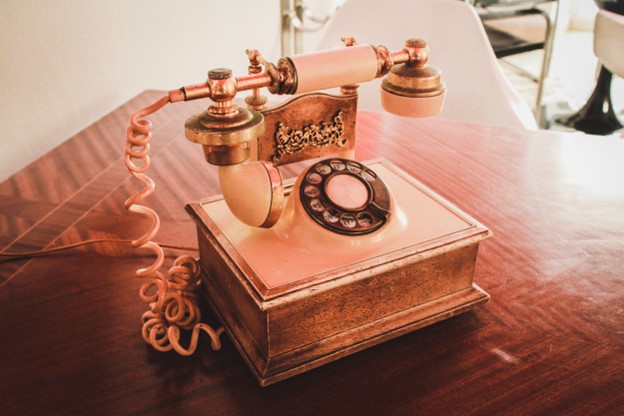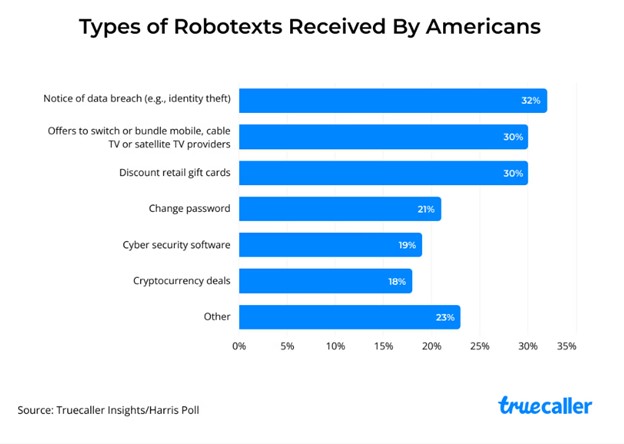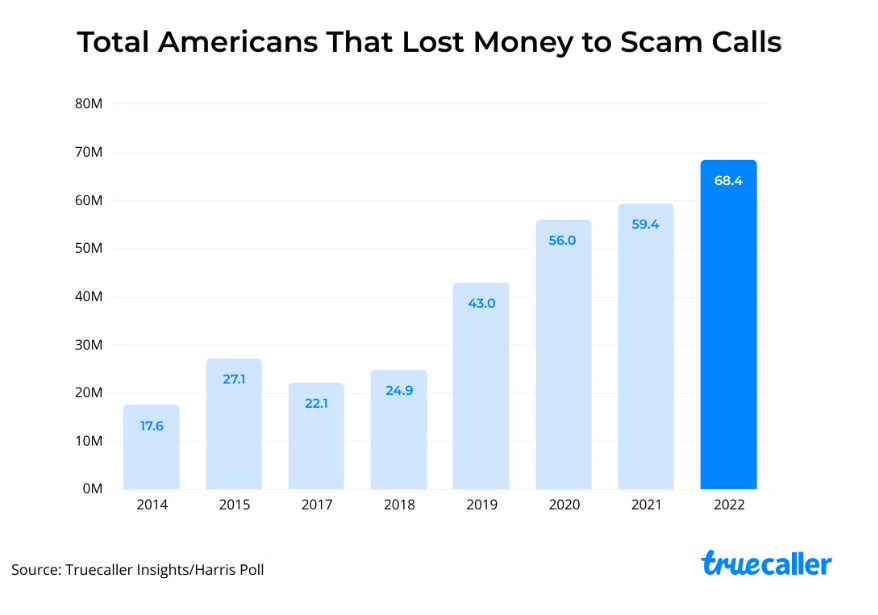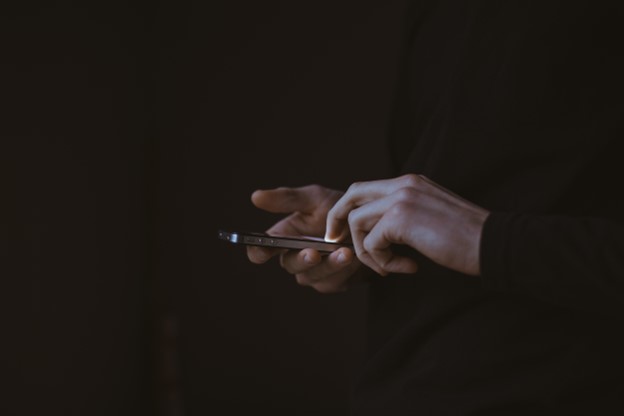And is your business phone number being used in phone scams?
Those born in the later years of Generation X (1965-1980) or early Millenials (1981-1996) may be the last to remember a childhood spent tethered to landline telephones as kids. Long gone are the good old days when once you left the house on your bicycle, your ability to call your friends was pretty much severed.
While the ability to communicate with others was far more difficult back then, the worst phone spam calls that most of us could expect were prank calls from bored kids with too much time on their hands.
Oh, how times have changed.
The first mobile phone was invented by Motorolla in 1973, and the first smartphone didn’t come until 1992 with the IBM Simon. While mobile phones became popular in the 1990s to early 2000s, they became ubiquitous after the release of the Apple iPhone in 2007.
The standard of nearly everyone being accessible via their mobile phone no matter where they are (95% of the population now has a cellular phone) has led to a subsequent rise in a shadowy industry: scam calls. As more people carry cell phones and smartphones, there are a growing number of bad actors with nefarious intent working to use that access to steal their money.
This has led to a tug-of-war between phone scammers, government agencies, and telephone companies with consumers caught in the middle. Thankfully, there is a solution today from Call Purity that can help your customers to spot inaccurate Caller ID information and remediate unwanted carrier tags with the telephone company if your numbers are improperly mislabeled.
To help you better understand why this is so important, we should go through the history of Caller ID spoofing and why it can be so detrimental to your business.
The Advent of Caller ID

Research and development for an early version of Caller ID was started back in 1968, with the first prototype created by Greek communications engineer Theodore George Paraskevakos in 1971. The phone companies originally wanted this to be a paid phone service, which would provide an audible announcement of who was on the other end of phone calls.
In 1976, however, Japanese inventor Kazuo Hashimoto created a caller ID prototype that could be built directly into the telephone set, putting the ability to have Caller ID directly into the hands of the end consumer. Bell South was the first service provider to deploy Caller ID commercially in Memphis, Tennessee, with full deployment to its entire region over the following four years.
The initial mobile phones did not have caller ID functionality, and T-mobile was the first major phone carrier to provide the service – at a fee, of course ($3.99 per month at the beginning).
Caller ID allowed the phone carrier to transmit information over the telephone line about who was calling, giving people an idea of who to expect before answering calls. As the technology progressed, Caller ID was able to provide more and more information to the end user, and people became more savvy at deciding whether to answer calls or not.
In some geographic regions, people are far less apt to answer an incoming call from an area code outside of their own. This led to the rise of neighbor spoofing (spoofing an area code to mimic the location being called), which is perfectly legal in some cases, but nefarious and illegal in others.
According to a recent poll by TrueCaller and Harris, slightly over half of Americans (51%) say that neighbor spoofing has increased for them over the past twelve months:

What is Caller ID Spoofing?
As defined by the Federal Communications Commission (FCC):
Spoofing is when a caller deliberately falsifies the information transmitted to your caller ID display to disguise their identity.
While we may associate a spoofed phone number immediately with a scammer or telemarketer, Caller ID spoofing has been used by law enforcement, government agencies, and collections companies for many years. Essentially, anyone with a specialized digital connection to the telephone company can make use of phone number spoofing.
The first mainstream caller spoofing service provider was Star38.com, through which customers could create a spoofed number by using the provider’s web interface. Once Star38.com launched and found success, many similar commercial phone number spoofing services quickly followed in their footsteps.
Is It the Same as Phone Number Spoofing?
Although the practice can be used in different ways and for different objectives (legitimate or illegitimate), Caller ID spoofing and phone number spoofing are the same thing. For whatever purpose, either term is used to denote providing a false Caller ID to hide the actual caller’s number.
How Caller ID Spoofing Works
Since its mainstream emergence in 2004, Caller ID spoofing has continued to evolve in its uses and the technology that allows it to access all your devices. As broadband internet continues to increase in both speed and available bandwidth, it is making the internet a more viable way for individuals and businesses to use the internet (VOIP) for their phone service.
As outlined below, however, VOIP is also one of the fastest-growing avenues for Caller ID spoofing service providers.
Voice Over Internet Protocol (VOIP services)
When most calls were made over the telephone line, Caller ID spoofing required advanced knowledge of telephony and was quite resource and time intensive. With open-source software that is now readily available on the market and the growing usage of VOIP telephone services, spoofing a phone number is becoming steadily easier and cheaper to do.
Some fraudsters will use VOIP and shell companies to create widescale Caller ID spoofing operations. In June 2012 there were nearly 50,000 consumer complaints logged about receiving multiple continuing spoofed calls through VOIP from a company called Pacific Telecom Communications Group in Los Angeles.
In violation of FCC rules, this company was “located” in a mailbox store, and leased out thousands of phone numbers to anonymous voice mail providers that would then conduct the phone spoofing to place unwanted calls.
Some VOIP providers allow users to configure their own call settings, which makes phone spoofing extremely easy to do. By using VOIP instead of traditional phone service, spoofed calls can be made from anywhere in the world without having to worry about outbound calling minutes or long-distance charges.
Voice Mail Spoofing
For most mobile phones, the voicemail box is directly accessible by a phone call from the owner’s number. If you don’t have a voicemail password or pin set for your account, phone spoofing can be used to call and listen to any new voicemail message.
Straight to Voicemail Message Spoofing
The person making the spoofed call may not want to actually interact with the person that they are calling, preferring just to leave a new voicemail message without showing up in the phone owner’s call history. Many commercial spoofing service providers provide this as an option, and the spoofed call can be sent directly to a voicemail box at the push of a button.
Commercial Spoofing Companies
Companies like SpoofCard sell themselves as providing the ability for spoofing to be used to protect the caller’s true identity. Their spoofing services can be used through a phone app or website, and the company even provides free trial credits to new users. All that a user has to do is log in, pay a per-call fee, and they can use VOIP services to spoof calls for whatever or to whomever they choose.
There are many similar commercial spoofing companies out there. While they sell themselves as offering privacy, they don’t mention the damage of unwanted calls being logged from a person or business’s legitimate phone number without their knowledge.
Many of these companies also provide text messages from a spoofed phone number, which is increasingly becoming a larger avenue of phone-based fraud and scams.
Spoofing for Text Messages
Scam, spam, and robo-text messages (robotexts) are also greatly increasing in the U.S. According to the same TrueCaller/Harris poll linked above, 85% of Americans say they have received a robotext outlining one of the following situations (from a spoofed phone number):

Why Spoof Calls in the First Place?
As mentioned above, people in certain geographical areas are less prone than others to answer any Caller ID that isn’t a local number. With the increasing number of telephone-based scams, the latest data shows that up to 86% of Americans try not to answer any calls from unknown callers, believing them to be warning signs of telemarketing calls or scams.
Americans are also hesitant to answer calls from 1-800 phone numbers that they don’t recognize, which can be an issue for legitimate companies that don’t use a service like Pure Branded Caller ID from Call Purity. If your legitimate business calls are seen as unknown or unrecognized numbers, there is a very high chance that they aren’t going to be answered.
Knowing the statistics above, spoofing is used in both legitimate and illegitimate (or illegal) situations in an attempt to get more people to answer the phone. Phone spoofing may be used by a government agency that needs to connect with people, a legitimate call center placing outgoing calls for businesses or unsolicited calls from scammers who are trying to wrongly obtain sensitive personal information or money (typically focused on the elderly).
Phone number spoofing is frequently used by scammers on sites like eBay, Craigslist, and Airbnb as well. These scams can work both ways (as either the seller or buyer), using a spoofed phone number to hide their true country of origin.
This can be to sell non-existent products or to elicit sensitive personal information from sellers. Some pranksters even use spoofed numbers to make angry phone calls, fake appointments at a doctor’s office, or book appointments with no intention of showing up.
Transmitting misleading or inaccurate Caller ID may seem like it would always be something done with nefarious intent, but in many situations, the spoofed number chosen is simply someone or a company trying to do what they can to get their call answered by changing their own phone number.
Why Would Someone Want to Use Fake Caller IDs?
As briefly described above, there are both legitimate and illegitimate reasons for spoofed calls. Here are some of the reasons that they are generally used the most, in both instances:
Legitimate phone spoofing:
● Law enforcement
● Government agency
● A doctor calling from their mobile phone with Caller ID information listing their office
● Collections agencies
● Private investigators
● Call center for a legitimate business
● Telemarketers using neighbor spoofing
Illegitimate reasons to use a phone spoofing service:
● Making threatening phone calls
● Prank calls
● Spam calls
● Fraudsters who need to hide their phone number
● Voicemail snooping
● SWATting (reporting false violent threats to police)
● Telephony denial of service attacks
● Online fraudsters on sites like eBay, Craigslist, and Airbnb
Are Scammers Spoofing My Business Phone Number?
Businesses often go to great lengths to protect their brand, brand image, and reputation. Unfortunately, an individual or business owner often doesn’t know how their phone number is displayed on the Caller IDs of the phones or devices that they are calling.
Even if you or your business aren’t a victim of Caller ID spoofing, there is a fairly decent chance that your company phone numbers may be showing up as unknown numbers, spam calls, scam calls, or telemarketer calls. In fact, a recent industry study found that an average of 25% of a business’s phone numbers that are used to make outbound calls are improperly labeled by the mobile carrier.
The same study found double the number of legitimate calls mislabeled at the carrier level in 2022 than they had found between all of 2018 through 2021. According to their estimates, that number is likely to double again in 2023.
As you consider the problem of nefarious spoofed numbers listed above and Americans harmed by phone scams discussed below, it makes sense. The government, mobile carriers, and landline exchanges are all doing what they can to keep Americans safe from fraudsters. Unfortunately, that means that a lot of innocent companies get caught in the crossfire.
With over three decades of experience in the industry and the strongest relationships with all Tier 1 mobile carriers in the U.S., Call Purity can help remediate your phone numbers that are improperly labeled as spam, scam, or telemarketing calls, provide verified Caller ID Branding to put your customers at ease, and even help your customers know that calls are coming from your legitimate phone numbers (and aren’t being spoofed).
How Big of a Problem Are Phone Scams?
Phone-based scams are an enormous problem in the U.S., and they’re only getting bigger, across every metric that is tracked. The amount of money that Americans lost in 2022 to phone scams is estimated to be $39.5 billion, and the problem doesn’t show any signs of slowing down.

The people and groups behind these phone scams obviously want to hide their true location, identity, and phone number behind the incoming call, which is why they use Caller ID spoofing. Scam and spam calls do great harm to legitimate companies that need customers or potential customers to answer their incoming call, but the data shows that they’re becoming less likely to do so:
● 86% of Americans only answer when they can identify the person or business that is calling
● 86% refuse to answer calls labeled spam, scam, telemarketer, or from unknown callers
● 25% of outbound phone numbers used by a legitimate business are likely to be mislabeled as spam, scam, or telemarketer by the mobile carriers
● Spam text messages have more than doubled over the past three years
Are the Government Agencies or Phone Companies Doing Anything About Spoofing?
With $39.5 billion lost by Americans to phone scams in 2022 alone, it’s plain to see that there is a lot of money being made by scammers. With that amount of money on the table, they are able to spend a substantial amount of time and resources dedicated to finding loopholes and technology around any new legislation that is implemented to stop them.
The Truth in Caller ID Act was created to try to find a middle ground that allowed legitimate Caller ID spoofing but outlawed the illegitimate type. It doesn’t take much to realize how difficult that would be, and the language of the legislation helps us see a glaring issue:
“FCC rules prohibit any person or entity from transmitting misleading or inaccurate caller ID information with intent to defraud, cause harm, or wrongly obtain anything of value.”
One of the most difficult things to prove in court is the intent of a person or organization, yet that is the key this legislation uses to differentiate between legal and illegal Caller ID spoofing. More recently the STIR/SHAKEN framework and Robocall Mitigation Database were implemented in an attempt to fight telephone-based fraud against Americans, but the statistics listed above show that the problem is only getting worse.
Some US states like Arkansas have created laws requiring that callers (except when used for law enforcement or public safety) must provide accurate information about their identity and location, with stiff penalties for those who don’t. Unfortunately, this will stop legitimate businesses from using Caller ID spoofing, but it’s not likely to stop nefarious foreign actors who reside outside of the jurisdiction of state authorities.
How Do I Know If My Phone Numbers Are Being Used for Spoofed Calls?
Unless you are an expert in telephony or unified communications, it’s not likely that you would ever know if your phone numbers are being used for Caller ID spoofing. Thankfully, our experts at Call Purity have over thirty years of experience in the Unified Communications, Call Centers, and Telecommunications industries.
With cloud-based solutions that don’t require any new software downloads or complicated third-party API integrations, our team at Call Purity can provide you with your own dashboard that provides a firsthand view of your outbound phone numbers. From our easy-to-use dashboard, you can manage your outbound numbers, monitor their health scores, and view all of your call-based analytics in one place.
How Can I Prevent My Phone Numbers from Being Used in Spoofing?
Pure Branded Caller ID from Call Purity provides your brand with a verified checkmark when calling, as well as the ability to choose how your phone number is displayed, and an option to display your logo and reason for calling, if desired.
According to our own internal studies, our clients are up to 3x more likely to have their calls answered when they begin using Call Purity for their branded calling.
This branded calling solution helps your customers feel confident in answering your call. The verified checkmark establishes the trust that it’s not a scammer on the other end of the line, and announcing the reason for your call provides an extra touch to help build your brand trust and reputation
Get More Calls Answered with Call Purity
If your company depends on phone calls and wants to maintain its brand reputation, the last thing that you want is for scammers to use your numbers in Caller ID spoofing to defraud Americans. Your numbers are likely to be labeled with harmful carrier tags, your brand reputation will be tainted, fewer calls will be answered – and you likely won’t even know about it.
Instead of sitting around and hoping that it doesn’t happen to you, call our experts at Call Purity today to take a proactive stance to protect your brand and guard against fraudsters. Our team can have harmful carrier tags removed in less than two days on average, and once we’ve remediated those numbers they aren’t likely to ever be mislabeled again.
On top of real-time monitoring of your call-based metrics and rapid remediation, our Pure Branded Caller ID solution can help you increase brand trust with customers, help them feel confident about answering your calls, and in return see up to a 3x lift in your call answer rates.
At Callpurity, our number one focus is helping clients get more calls answered by live human beings. We take that focus seriously and have thirty years of experience with scores of happy clients because we do it so well. Let our experts help you connect with more customers.
Trust matters. Begin building it from the first call with Callpurity.



